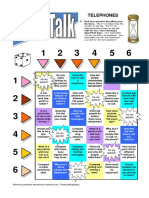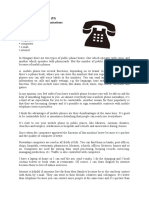Transcript: “Listening Time” Episode 70
Welcome to the Listening Time podcast. Hey everybody, this is Conner, and
you're listening to Episode 70 of the Listening Time podcast. I hope you're all doing very
well. I want to thank all of my Listening Time Members, Super Members and Family
Members. Thank you for helping me and for supporting what I do. If you'd like to support
me, then please consider becoming a member. And of course, if you want my extra
content, if you want my specialized training to help you with your listening and
pronunciation, and if you want my bonus episodes, then make sure to become a
member as well.
And of course, if you want my advanced podcast episodes, then become a
Listening Time Family Member. Every month, you get two new advanced episodes
where I speak fast, at normal speed, and I provide the transcript to help you understand
what I'm saying. So, of course, this will help you reach an advanced level of listening
because you'll get to practice with real English. A lot of people ask me how they can
move beyond my podcast and start to understand normal English, start to understand
normal English speakers, and I always tell them: my advanced podcast is what you
need. This will help you make that transition to finally understand native speakers when
they speak fast. So, make sure to sign up today if you want that.
Alright, so in today's episode, we're going to talk about cell phones. This is a
good topic to talk about because most of us use a cell phone or multiple cell phones on
a daily basis. And this is a very important part of our lives because we use cell phones
for so many different things nowadays. And so, I thought it would be a good topic to talk
about in this episode.
So, remember that you have the transcript available for this episode underneath
the episode in the Episode Description. Just go down and click on that, and listen to this
episode as many times as you need with or without the transcript until you can
understand everything that I'm saying. This is a great technique to help train your
listening. And if you like this podcast, please give it a five-star rating, and share it with
anyone else who might find it useful. This really helps the podcast grow. Alright, let's get
started.
Okay, so let's talk about cell phones. First, I want to talk about cell phones from
the past, the cell phones that I remember when I was growing up. So, I remember, when
I was in middle school, and in my early years of high school, that almost everyone had a
flip phone. A flip phone is a phone that folds. It has two parts and you have to open it.
I'm sure a lot of you remember these types of phones. I had flip phones when I was
younger. I think my first three phones were flip phones, if I'm not mistaken. So, for a
while, this was the standard. This was the normal type of phone that most people had.
And I thought these phones were pretty cool. I liked opening it up and using my thumb
to kind of flip it open and I thought that was a pretty cool invention at the time.
And those first phones that a lot of us had were mostly for calling and texting.
They were actually phones, right? We used them mostly to communicate with other
people, because most of them didn't have the internet. And so, we couldn't really do
anything online with those phones. And I remember during those days, I made more
phone calls than I do now. I talked to more people on the phone. I remember talking to
my friends on the phone in the evening after school. I even remember having group
�phone calls with more than two people. And so, this was really normal back in the day.
In English, when we use the phrase “back in the day,” we just mean “in the past.” So,
back in the day, it was really normal for people to make a lot of phone calls from their
cell phones. And this was the primary way that a lot of people talked to each other.
And a lot of people didn't have unlimited texting plans. So, text messages were
limited then. And so, we didn't want to use all of our texts and waste all of our
messages, so we would try to call each other and then, sometimes, text each other. And
I also remember that another thing that I thought was really cool with those original
phones was that a lot of us used different ringtones for different people. In English, the
word “ringtone” refers to the music or the sound that you hear when someone calls your
phone. This is a ringtone. So, I remember that I put a different ringtone for different
friends. And we thought this was so cool to have, like, a customized ringtone that
matched this specific friend and that specific friend. And we had a lot of fun with this.
And it was something we thought was cool.
And I also remember at that time that the coolest phone on the market was the
Blackberry. I'm sure some of you remember this phone. I don't know if a lot of people
still have this phone. Maybe they do. I don't know. But I remember back then, when we
saw people using a Blackberry, we thought that that person was cool or he was a
businessman or someone rich or important or something like that. And so, Blackberries
at that time were kind of like a status symbol. I think a lot of businessmen had them. In
English, when we say the phrase “status symbol,” we're saying that something reflects a
certain status. So, if I say that blackberries are a status symbol, this means that if you
have a Blackberry, it tells other people that you have a certain status in society. You’re
high class, or something like that.
And I also remember that at that time, camera phones were just starting to come
out. And before, when I had my first two phones, I think, or three phones… I don't
remember… but my first phones didn't have a camera. So, I didn't even think about
taking pictures or videos or things like that. But then, suddenly, camera phones came
onto the market, and a lot of people wanted these phones so they could take pictures.
And this really changed the game for cell phones.
Alright, let me talk a little bit about cell phones nowadays. So, nowadays, cell
phones are basically little computers. They do the same thing that your computer does,
but they're much much smaller. So, calling people is a minor feature in today's cell
phones. In English, the word “feature” refers to a characteristic that something has or
that someone has. For example, I could say, “His best feature is his personality.” This
means that his best characteristic is his personality. So, calling is kind of a minor feature
nowadays with cell phones. People don't really focus on the call quality or how well the
phone calls other people. People don't really think about this when they buy a new
phone. They think about all the other things that the phone does. They have different
priorities nowadays when they go shopping for phones.
So, nowadays, we have many, many apps that we can download onto our
phones and use them to do a lot of different things. So, there's an app for everything,
basically. And this has really changed the way that we interact with our cell phones, and
it's changed the way we interact with each other, really. And so, these apps can be
really useful, and some of them aren't that necessary or useful, but they're fun or
interesting, or they're attractive, and so people might download them. So, not all of
�these apps are necessary, and I don't necessarily have a ton of apps on my phone, but
it's cool that we can download different apps for different purposes and do a ton of
different things, and our phones have so much power with these apps now.
One thing that is really popular now, that's really standard for cell phones
nowadays, is to be used for group messaging. So, I'm sure that you or other people that
you know, are involved in some type of group message, whether that be with WhatsApp
or some other app like that, where you're talking to different people, more than just one
other person, and you constantly write messages in this group, and it never closes or
goes away or is deleted. You just keep this group message open indefinitely. In English,
when we say the word “indefinitely,” we're saying that something is going to stay until
the future, and there's no end date. It's not going to end at any specific point. It's
indefinite.
So, you we keep these group messages, these group chats, open indefinitely,
and whenever you want to say something to that group, you just write a message there
and interact with people there. So, this is one of the most normal ways that people keep
in touch with each other or with their family nowadays, is with this group messaging
through their phones.
And now, another thing that people use their phones for that we couldn't do with
the first phones that we had is listen to a lot of music on this phone. I don't really
remember when phones became a big music-playing device. Maybe it was with the
iPhone, I don't remember. But when I had my first phones, I never listened to music on
them. However, nowadays, it's very normal to listen to music on your phone. And so, it
acts kind of like an iPod and a phone together, right? You can listen to music, and it's
good quality, and you just put your headphones in. And a lot of people do this on a daily
basis. So, that's another feature of today's phones.
And another one that's really important that I mentioned is we have cameras
now, and we have video, and not only that, we also have professional-quality cameras
and professional-quality video. The quality of some of the cameras on the newest
phones of today is really really impressive. So, people can use these phones to take
professional-like photos and record YouTube videos, and it looks fantastic.
And it's really amazing what these phone creators have done with the camera
and video app because they have really come a long way. In English, when we use the
phrase “come a long way,” we’re saying that something has evolved a lot over the
years. It's become something very different from what it was earlier or prior. So, the
cameras that we have in our phones today have come a long way from the cameras
that we had in our first phones. So, they're very, very impressive and we can do a lot of
things with them. And many professionals use these cameras and use the video to do a
lot of different projects. So, that's pretty cool as well.
Alright, now, let me talk about what I use my phone for and what I don't use it for.
So, what I use my phone for: first of all, I use it to message, and I call a little bit. I don't
call people very often. I usually just call my dad, for example, once in a while, but I don't
call that many people nowadays. I used my first phones to make a lot more calls when I
was younger than I do nowadays, but I still do this a little bit. And I send messages, of
course. So, I can send messages to people. That's a basic feature of today's phones, of
phones from the past and today, really. And so, of course, I use this feature as well.
� I use my phone to check my email. So, I check my email probably every day from
my phone. So, that's something that's very useful because I can check my email when
I'm out and about. In English, when we use the phrase “out and about,” we’re saying
that you're outside the house doing other things. So, when I'm out and about, I can
check my email just to see if I need to respond to something, if there are any urgent
messages, or things like that. So, that's pretty useful.
I also use my phone for navigation and for ride sharing. So, that's another really
useful feature of today's phones is that we have navigation on them. And so, if I need to
find my way to some place, if I need to go somewhere new, I can use these different
navigation apps to help get me there. And of course, I can use my phone for ride
sharing. So, for example, here in Mexico, one of the most popular apps, and one that I
use a lot, is DiDi. This is an app that's similar to Uber, and I use this a lot to get around
the city, and it's super convenient. So, that's another app that I use a lot on my phone.
And I also use my phone a lot for language learning. When I'm walking outside…
for example, if I'm outside with my son in the stroller and he's asleep, I often listen to
YouTube videos in other languages, like French, to help me with my French listening
practice. And also, if I go to the gym, I can also take my phone with me and listen to
YouTube videos or podcasts in French as well. So, language learning is another thing
that has been made easier with cell phones because we can do more language learning
nowadays. We can take our language learning with us when we go outside, when we go
to different places. So, that's something that's really useful for me. And it's one of the
things that I do the most on my phone.
Alright, now, let me talk about what I don't use my phone for. You might
remember that, in an earlier episode, or maybe it was a bonus episode… I forget… but
in one of my earlier episodes, I talked about the fact that I don't use social media
anymore. I don't use any social media app for personal use. So, I don't use Facebook. I
don't use Instagram. I don't use Twitter, Snapchat, any of those things. Of course, I have
my Instagram account for Listening Time, and I post on there sometimes, but I don't
have any social media network app that I use for myself. So, I don't use it for that, and
so, I don't spend a lot of time on my phone nowadays. I think that most people spend a
lot of time using social media on their phones, and this is probably the majority of their
usage. But I don't use my phone at all for social media nowadays.
And another thing that I don't use my phone for that much is taking pictures. I
think I took more pictures in the past, but nowadays, I rarely take pictures with my
phone. Sometimes, I'll see something that I really want to take a picture of, or there
might be something really important that I want to take a picture of so that I can
remember it and go back to it in the future, for example. But usually, I don't take a lot of
pictures. I'm not very good at that, and so, I look back at my old photos, and I think
“Wow, I've only taken a few photos this year; I should have taken a lot more,” especially
now that I have a son and I want to capture a lot of those moments. But I'm not very
good at remembering to take pictures throughout the day. So, I don't do this a lot with
my cell phone.
And one other thing that I don't really use my phone for a lot is messaging apps. I
know this might be a surprise for a lot of you. But I do not like messaging apps like
WhatsApp and things like this. I've never liked them, and I don't like them now. And I try
not to use these types of apps if I don't have to. And like I said, a lot of you are probably
�really shocked to hear that. In English, when we say that you're “shocked,” it means that
you're really surprised by something. So, I'm sure a lot of you are shocked to hear that
because in most countries nowadays, these messaging apps are normal and everyone
uses them and everyone has to have them, and this is the way that people
communicate with each other.
However, in the US, these messaging apps are not that common, actually. In the
US, I never use these messaging apps if I go there. I've never talked to any family
member or friend in the US using these messaging apps. And so, I only have these
apps because I live in Mexico and everyone here uses these apps, and so, it's
necessary. However, in the US, people don't like these apps, in general. People don't
use them. And I'm one of those people. And I've just never gotten used to using it, and I
just don't like it that much, to be honest. And you're probably wondering why people in
the US don't use these apps.
And I think one of the main reasons why is because in the US, many many
people have iPhones. So, a lot more people in the US have iPhones than people in
other countries. And when you have an iPhone, you have this feature called iMessage
that's specifically for iPhones messaging other iPhones. And so, because so many
people have iPhones in the US, people just use this iMessaging feature, and it works
very similar to WhatsApp or other messaging apps. And you can have big group
messages with a lot of people that have iPhones through this iMessage feature. And
this is really normal. For example, when I think about my own family members,
everyone has an iPhone, 100% of them. And so, it's very easy to have these iMessage
groups, and this is pretty normal in the US.
And so, that's an interesting topic because in a lot of other countries, iPhones
aren't as accessible, and they're much more expensive, sometimes even double the
price than in the US. And so, we don't have this same iPhone culture in other countries.
In other countries, iPhones are seen more as a luxury or a status symbol. But in the US,
it's really normal to have an iPhone or to have a MacBook computer. These are very
normal things.
And I don't have the statistics in front of me, so I can't say for sure, but I would
assume that most people in the US have an iPhone. And sometimes, when you don't
have an iPhone, people ask you “Why”? Like, there's some reason that you have to
have to not have an iPhone. That's how popular they are in the US. So, because of that,
people use iMessage, and they don't use these messaging apps as much, and I think
that explains this difference.
Alright, well, why don't we stop there for today? I hope this episode was
interesting for you. I hope that it was good practice for your listening skills. Remember
that you have the transcript available for this episode below the episode, so go down
and click on it. And if you want my advanced episodes, then make sure to become a
Listening Time Family Member. If this podcast has become easy for you, if it's really
comfortable, and it's not that much of a challenge, then it's definitely time for you to
become a Listening Time Family Member so you can use my advanced episodes to
train with real English, with fast spoken English. Okay? So, make sure to sign up. That's
www.patreon.com/listeningtime
The link is in the Episode Description below this episode. So, go ahead and click
on that and sign up today. And remember that if you like this podcast, please give it a
�five-star rating, and share it with anyone else who might find it useful, and help this
podcast grow. Alright, well, thank you for listening to this episode, and I'll talk to you on
the next episode of Listening Time.
*Click on this link to access my Advanced Episodes, Bonus Episodes, and Listening
Practice Seminars: www.patreon.com/listeningtime























































































